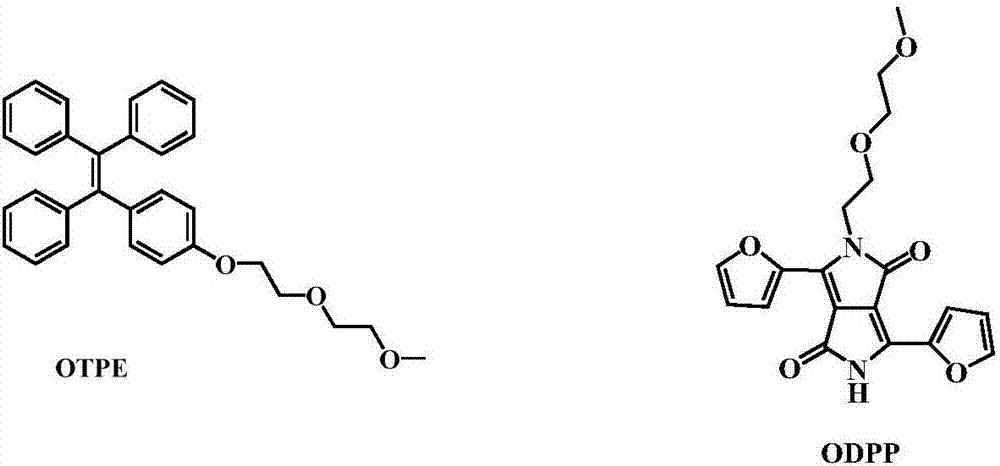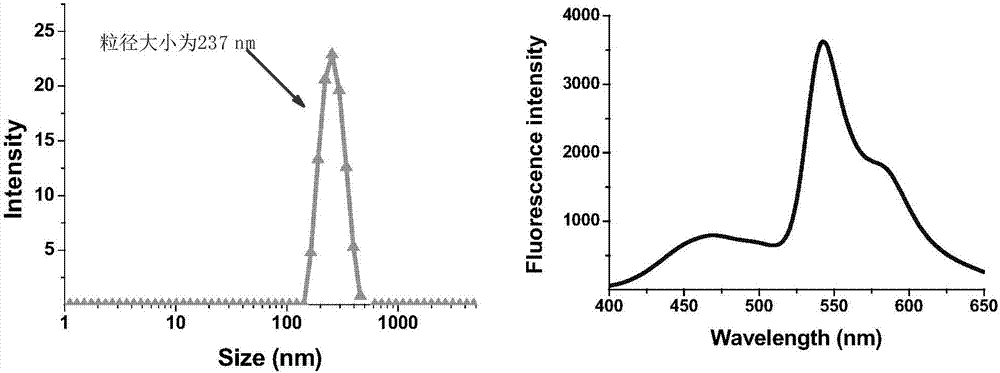Multifunctional organic fluorescent nanoparticle based on diketopyrrolopyrrole compounds and tetraphenyl ethylene compounds as well as preparation and application
A technology of diketopyrrolopyrrole and fluorescent nanoparticles, which is applied in the fields of organic chemistry, fluorescence/phosphorescence, chemical instruments and methods, etc., can solve the problems of unguaranteed stability, no fluorescence or weak fluorescence, and difficult application. , to achieve the effect of being conducive to large-scale production and application, simple preparation method and maintaining stability
- Summary
- Abstract
- Description
- Claims
- Application Information
AI Technical Summary
Problems solved by technology
Method used
Image
Examples
Embodiment 1
[0035] Preparation of multifunctional fluorescent nanoparticles. like figure 1As shown, in this example, two kinds of alkoxy-modified fluorescent molecules (ODPP and OTPE) were used as raw materials to prepare multifunctional fluorescent nanoparticles. In water, add two fluorescent compounds at a ratio of ODPP:OTPE of 1:4 to make the total concentration 50 μM / L. The self-assembly of amphiphiles ( figure 2 ), and the desired nanoparticles were prepared after ultrasonication for 0.5 hours. like image 3 As shown, the left picture is the hydrated particle size of nanoparticles measured by laser dynamic light scattering method, and the right picture is the fluorescence emission spectrum.
Embodiment 2
[0037] The fluorescence emission spectra of fluorescent nanoparticles in response to mercury ions are as follows: Figure 4 shown. In aqueous solution, the nanoparticles have emission peaks at 470nm and 540nm, corresponding to the fluorescence emission of TPE and DPP, respectively. With the addition of mercury ions, the fluorescence of TPE did not change much, while the fluorescence intensity of DPP gradually weakened. Use F 540 / F 470 to [Hg 2+ ] plotting to get Hg 2+ The limit of detection was 13 nM.
Embodiment 3
[0039] Application of fluorescent nanoparticles in dual-channel fluorescence imaging of cells. Add 21 μg / mL nanoparticle DPBS solution to the cultured dish with appropriate cell concentration and incubate for 0.5 hours. After washing away the nanoparticles in the culture dish with DPBS solution, the cells were imaged with a confocal fluorescence microscope. As shown in Figure 5, the nanoparticles can enter the HeLa cells well, and the fluorescence images obtained by both channels can clearly show the cytoplasm and nucleus.
PUM
 Login to View More
Login to View More Abstract
Description
Claims
Application Information
 Login to View More
Login to View More - R&D
- Intellectual Property
- Life Sciences
- Materials
- Tech Scout
- Unparalleled Data Quality
- Higher Quality Content
- 60% Fewer Hallucinations
Browse by: Latest US Patents, China's latest patents, Technical Efficacy Thesaurus, Application Domain, Technology Topic, Popular Technical Reports.
© 2025 PatSnap. All rights reserved.Legal|Privacy policy|Modern Slavery Act Transparency Statement|Sitemap|About US| Contact US: help@patsnap.com



